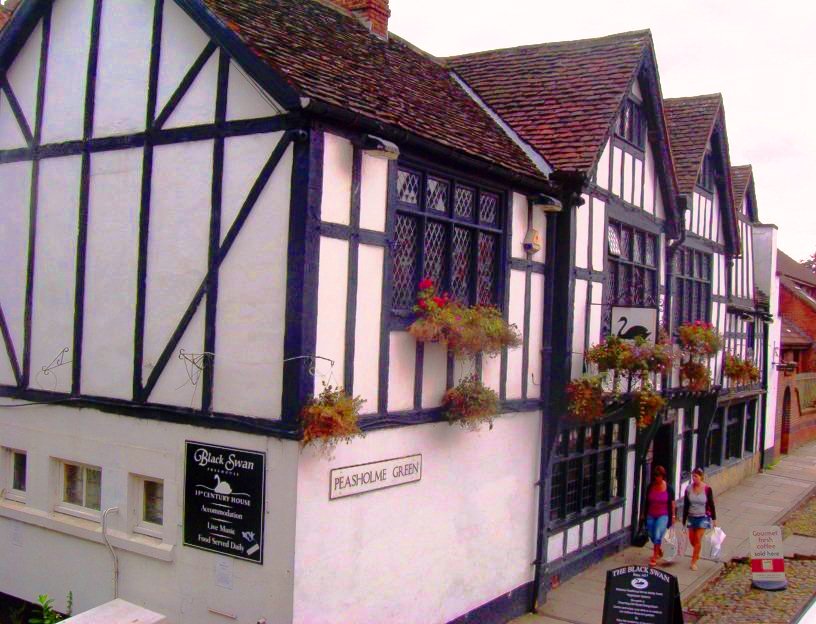Black Swan’s Canadian Connections
I was emailed today with what I thought was a neat question. Derek from St. John’s asked me “What building is in your gravatar? It looks quite old.” It is an old building actually. Well, old by Canadian standards I suppose. It is the Black Swan Guesthouse on Peasholme Green in York, England. It was built in 1417 for William Bowes who became Lord Mayor of York that same year. The Bowes went on to make quite a name for themselves as a family of goldsmiths to the Tudor Kings and Queens and William’s son Martin became Lord Mayor of London. Martin was also an advid heritage conservationist! He intervened in the proposed demolition of several medieval churches in York, including St. Cuthbert’s and the York Rectory, by arguing that these buildings were still in great shape and were links to the City’s historic past and should be saved. He then went on to restore the Church so it could be passed down to us in good condition today. But the real reason I use this building pictured above as my gravatar is its Canadian connections….
My grandfather and his buddies with the Thunderbird Squadron 426 of the Royal Canadian Air Force frequented the Black Swan alot during their time there from 1942-1946. Though Betty’s Bar will forever be the iconic gathering place for Canadian airmen in York during World War Two other local pubs, like the Black Swan, drew in many others. I was told my grandfather liked this place for its cozy atmosphere and the ability to blend in and chat with the locals. And I think meeting my grandmother here was a bit of an influence, I’m sure! But before the RCAF were here, there was another Canadian connection to this pub.
We all know the story of how General James Wolfe of York, England, defeated the French in Quebec in 1759, which brought an end to the Seven Year’s War. Wolfe was fatally wounded during the last epic seige and his death was captured in a world famous painting by artist Benjamin West called The Death of General Wolfe which is on display at the National Gallery in Ottawa. Wolfe’s parents had lived in the Black Swan from 1724 to 1726 when it was still a private residence. There have been a number of conflicting reports over the years that General Wolfe had actually been born in this house. But the offical story from the Black Swan is that Wolfe’s parents left for another home in York six months prior to his birth. The Black Swan remained a private residence until the later part of the 1750′s, when it was converted into a pub/lodging house. The first record of the Black Swan being a guesthouse is in 1763, when an ad appeared in a local York based newspaper.
The building has changed a little bit over its history. The three gables were added in the 1550s and extensive renovations and additions to the back were done in the 1640s. The interior boasts solid oak beams and posts, secret passages to a room believed to have once been a 17th century cock fighting pen and the staircase up to the guestrooms have depressions in the steps from centuries of footware trodding up and down the stairs. The original fireplace is still there and the mantle in the smoking room sports both a modern Canadian flag as well as the RCAF World War Two Ensign, to pay homage to the Black Swan’s Canadian roots. It is a fantastic little pub and if you’re in York, do go as the food there is awesome. It is right across the street from St. Cuthbert’s Church. So, you can sit beside one of the original windows with your pint and gaze upon the Church that Martin Bowes, son of the Black Swan’s builder, fought hard to save from demolition.
So there is the little story about a little gravatar! Thanks for the question, Derek.




What a great story, once again I’ve learned something new. Wonderful pictures. Well done Laura.
Thank you, Joyce. Glad you liked it.
Cheers,
Laura
Dear Laura
I am a volunteer history researcher for the NT at Beningbrough Hall. On 26 May 2011, members of No 426 Sqn opened a memorial room to the RAF & RCAF aircrew who were billeted at The Hall from 1941 to 1945.
The NT is looking to gather further stories about the RCAF and especially photographs. I was very interested to read your article and wondered whether you might have any information or memorabilia that you might wish to contribute?
Yours sincerely
Ted Sumner
Hello Ted,
Thank you very much for your comment and the update on the 426 memorial room at Beningbrough Hall as well as your contact number. I’ve had the pleasure of visiting this site a number of times. My grandfather, whom I spoke about in the Black Swan article, was an airframe mechanic with the 426 Squadron based at Linton-on-Ouse. He was there from 1942 until late 1945. I would like to contribute to your memorial room. If you can give me an example of things that have been collected, that would be great. My plan for a couple months now has been to write an article for this site about the social and cultural impact the RCAF had on the landscape of Yorkshire. My PhD thesis topic directly addressed this as well.
Feel free to email me under the “contacts” section with any information about what you are looking for.
Cheers,
Laura